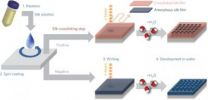(Press-News.org) BUFFALO, N.Y. – One of the serious health consequences of obesity is elevated blood pressure (BP), a particular problem in children because research has found that high BP in children usually follows them into adulthood, carrying with it a wide range of possible negative consequences.
Even modest elevations in the BP of adolescents, according to recent research, can pose cardiovascular problems later in life.
A systematic review and meta-analysis of published studies of the effect of child obesity intervention programs on blood pressure has found that whether such programs prevented obesity or not, many of them reduced BP in children. It also found that the most effective programs in this regard promoted both healthy eating and physical activity.
The study, one of the first of its kind, "Effect of Childhood Obesity Prevention Programs on BP: A Systematic Review and Meta-Analysis," was led by epidemiologist Youfa Wang, MD, PhD, of the University at Buffalo and conducted by researchers from Johns Hopkins University, UB and other institutions.
It was published online in the journal Circulation on Feb. 19, 2014 in advance of print publication.
Wang said, "Of the 28 obesity interventions with complete data that we analyzed, 13 (46 percent) had a favorable effect on both adiposity and BP and 11 interventions (39 percent) had a significant effect on the reduction of BP, even if they did not affect adiposity.
"It is important to identify obesity intervention programs that can help children develop healthy lifestyles and keep BP at an optimal level," he says, "because these programs help them avoid many long-term health consequences."
Wang's research team, now based at UB, is working on projects in the U.S. and abroad funded by the National Institutes of Health (NIH) that aim to assess the additional benefits of obesity prevention programs for children and to develop the most effective programs possible.
The team also is using transnational comparison studies to analyze factors suspected of contributing to the global obesity epidemic.
Wang, an internationally recognized obesity expert, is professor and chair of the Department of Epidemiology and Environmental Health in the UB School of Public Health and Health Professions. The study's first author, Li Cai, PhD, was a postdoctoral fellow who worked with Wang at Johns Hopkins.
Although many scientists contributed data to the current study, the additional principle contributors are Renee F. Wilson and Jodi B. Segal of the Bloomberg School of Public Health, Johns Hopkins University, and Miyong T. Kim, of the University of Texas, Arlington.
This study was built upon previous comprehensive research led by Wang at Hopkins and funded by the U.S. Department of Health and Human Services' Agency for Healthcare Research and Quality (AHRQ), which resulted in an 835-page full report published by AHRQ in June 2013.
The aim of the AHQR-funded study was to learn what intervention programs worked to prevent obesity in children. Wang calls it "a comprehensive and demanding two-year effort by more than 20 investigators from multiple institutions." It examined more than 130 studies published between 1985 and 2013 that were conducted in high-income counties worldwide.
Wang also points out that the strong evidence of childhood BP tracking into adulthood and cited above was reported by members of his research team based on more than 50 cohort studies of diverse populations worldwide. That research, which also noted the importance of early intervention, was published in Circulation in 2008.
INFORMATION:
Whether they reduce fat or not, obesity programs lower kids' blood pressure
2014-03-28
ELSE PRESS RELEASES FROM THIS DATE:
Stigmas, once evolutionarily sound, are now bad health strategies
2014-03-28
Stigmatization may have once served to protect early humans from infectious diseases, but that strategy may do more harm than good for modern humans, according to Penn State researchers.
"The things that made stigmas a more functional strategy thousands of years ago rarely exist," said Rachel Smith, associate professor of communication arts and sciences and human development and family studies. "Now, it won't promote positive health behavior and, in many cases, it could actually make the situation worse."
Stigmatizing and ostracizing members stricken with infectious ...
Fabricating nanostructures with silk could make clean rooms green rooms
2014-03-28
MEDFORD/SOMERVILLE, MASS. -- Tufts University engineers have demonstrated that it is possible to generate nanostructures from silk in an environmentally friendly process that uses water as a developing agent and standard fabrication techniques. This approach provides a green alternative to the toxic materials commonly used in nanofabrication while delivering fabrication quality comparable to conventional synthetic polymers. Nanofabrication is at the heart of manufacture of semi-conductors and other electronic and photonic devices.
The paper describing this work, "All ...
Safety and immunogenicity of 2 doses of the HPV-16/18 AS04 adjuvanted vaccine Cervarix
2014-03-28
A recent study in the journal Human Vaccines & Immunotherapeutics, showed that two doses of the HPV-16/18 AS04-adjuvanted vaccine Cervarix (GlaxoSmithKline) are non-inferior to three-doses in the current schedule.
Since high coverage and compliance rates can be difficult to achieve with the current three-dose HPV vaccineregimen, several studies have looked at the possibility of reducing the number of doses. Proof-of-principle that a two-dose schedule can provide sufficient protection against cervical cancer came initially from a study performed in Costa Rica in 2011. ...
Repeated hUCB injections may improve prognosis of children with deadly inherited disorder
2014-03-28
Putnam Valley, NY. (Mar. 28 2014) – New insight has been gained into treating an inherited disorder that creates serious neurological and behavioral disabilities in children and usually leads to death in the teen years.
In a recent study into the effects of human umbilical cord blood mononuclear cells (hUCB MNCs) when they are injected to counter the symptoms and progression of Sanfilippo syndrome type III B (MPS III B), researchers found that repeated injections into laboratory mice modeled with the disorder had clear benefits for the mice receiving multiple injections ...
Rainbow-catching waveguide could revolutionize energy technologies
2014-03-28
BUFFALO, N.Y. – More efficient photovoltaic cells. Improved radar and stealth technology. A new way to recycle waste heat generated by machines into energy.
All may be possible due to breakthrough photonics research at the University at Buffalo.
The work, published March 28 in the journal Scientific Reports, explores the use of a nanoscale microchip component called a "multilayered waveguide taper array" that improves the chip's ability to trap and absorb light.
Unlike current chips, the waveguide tapers (the thimble-shaped structures above) slow and ultimately absorb ...
Gene may predict if further cancer treatments are needed
2014-03-28
DALLAS – March 28, 2014 – UT Southwestern Medical Center researchers are developing a new predictive tool that could help patients with breast cancer and certain lung cancers decide whether follow-up treatments are likely to help.
Dr. Jerry Shay, Vice Chairman and Professor of Cell Biology at UT Southwestern, led a three-year study on the effects of irradiation in a lung cancer-susceptible mouse model. When his team looked at gene expression changes in the mice, then applied them to humans with early stage cancer, the results revealed a breakdown of which patients have ...
Erectile dysfunction can be reversed without medication
2014-03-28
Men suffering from sexual dysfunction can be successful at reversing their problem, by focusing on lifestyle factors and not just relying on medication, according to research at the University of Adelaide.
In a new paper published in the Journal of Sexual Medicine, researchers highlight the incidence of erectile dysfunction and lack of sexual desire among Australian men aged 35-80 years.
Over a five-year period, 31% of the 810 men involved in the study developed some form of erectile dysfunction.
"Sexual relations are not only an important part of people's wellbeing. ...
NUS researchers developed world's first fluorescent sensor to detect date rape drug
2014-03-28
A team of researchers from the National University of Singapore (NUS) has developed the world's first fluorescent sensor to identify the presence of a drug known as GHB that is commonly used to spike beverages. When the sensor is mixed with a sample of a beverage containing GHB, the mixture changes colour in less than 30 seconds, making detection of the drug fast and easy.
This simple mix-and-see discovery, led by Professor Chang Young-Tae of the Department of Chemistry at the NUS Faculty of Science, is a novel scientific breakthrough that contributes towards prevention ...
More male fish 'feminized' by pollution on the Basque coast
2014-03-28
The UPV/EHU's Cell Biology in Environmental Toxicology group has conducted research using thick-lipped grey mullet and has analysed specimens in six zones: Arriluze and Gernika in 2007 and 2008, and since then, Santurtzi, Plentzia, Ondarroa, Deba and Pasaia. The acquisition of feminine features by male fish has been detected, to a greater or lesser extent, in all the estuaries, not only in the characteristics of the gonads of the specimens analysed but also in various molecular markers. According to Miren P. Cajaraville, director of the research group, the results show ...
Fingerprint of dissolved glycine in the Terahertz range explained
2014-03-28
Chemists at the Ruhr-Universität Bochum (RUB) have, for the first time, completely analysed the fingerprint region of the Terahertz spectrum of a biologically relevant molecule in water, in this case, an amino acid. By combining spectroscopy and molecular-dynamics simulations, they rendered the motion of the most basic amino acid, glycine, visible in an aqueous solution. Their results have disproved the long-standing theory that frequencies in the Terahertz range provide no information regarding the amino acid's motion. The team led by Prof Dr Martina Havenith-Newen and ...





